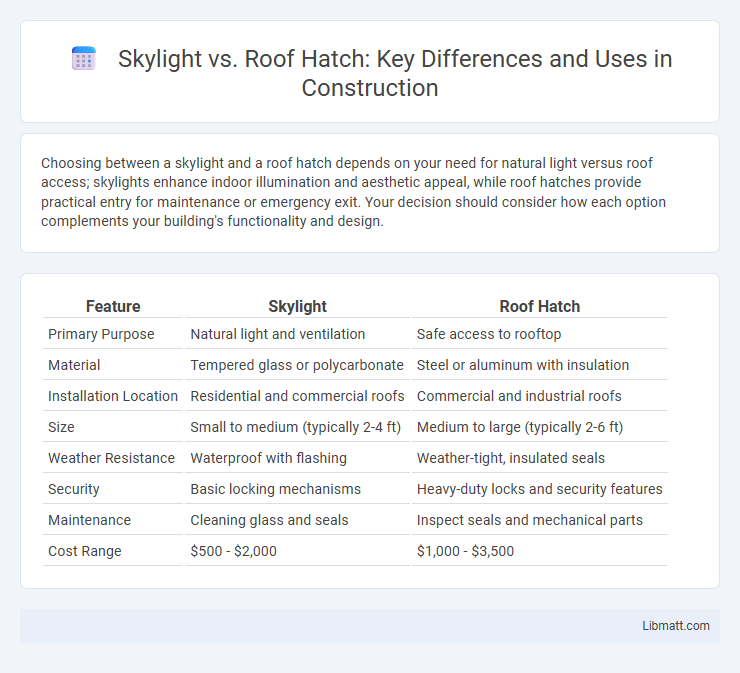Choosing between a skylight and a roof hatch depends on your need for natural light versus roof access; skylights enhance indoor illumination and aesthetic appeal, while roof hatches provide practical entry for maintenance or emergency exit. Your decision should consider how each option complements your building's functionality and design.
Table of Comparison
| Feature | Skylight | Roof Hatch |
|---|---|---|
| Primary Purpose | Natural light and ventilation | Safe access to rooftop |
| Material | Tempered glass or polycarbonate | Steel or aluminum with insulation |
| Installation Location | Residential and commercial roofs | Commercial and industrial roofs |
| Size | Small to medium (typically 2-4 ft) | Medium to large (typically 2-6 ft) |
| Weather Resistance | Waterproof with flashing | Weather-tight, insulated seals |
| Security | Basic locking mechanisms | Heavy-duty locks and security features |
| Maintenance | Cleaning glass and seals | Inspect seals and mechanical parts |
| Cost Range | $500 - $2,000 | $1,000 - $3,500 |
Introduction: Skylight vs Roof Hatch Overview
Skylights and roof hatches serve distinct purposes in building design, with skylights primarily providing natural light and aesthetic appeal, while roof hatches offer access for maintenance and emergency exits. Skylights are typically made of glass or acrylic and are sealed to prevent water intrusion, enhancing interior daylighting. Roof hatches are constructed with robust materials and equipped with secure locking mechanisms to ensure safety and weather resistance during rooftop access.
Key Differences Between Skylights and Roof Hatches
Skylights are designed primarily to provide natural daylight and improve ventilation within interior spaces, featuring transparent or translucent materials like glass or acrylic. Roof hatches serve as access points to rooftops for maintenance or emergency egress, constructed with sturdy, often insulated materials for safety and weather resistance. Unlike skylights, roof hatches prioritize structural integrity and functionality over light transmission, making their design and installation distinct to meet these specific purposes.
Design and Aesthetic Considerations
Skylights offer a sleek, modern design that enhances interior ambiance by allowing natural light to flood spaces, creating an open and airy atmosphere. Roof hatches focus more on functionality with a utilitarian design, providing access for maintenance rather than aesthetic appeal. Choosing between them depends on whether Your priority is visual impact or practical rooftop access.
Functionality and Primary Use Cases
Skylights provide natural daylight and ventilation, enhancing indoor lighting and reducing energy costs primarily in residential and commercial spaces. Roof hatches offer secure roof access for maintenance, emergency exits, or equipment installation, commonly used in industrial and commercial buildings. While skylights focus on aesthetic and environmental benefits, roof hatches prioritize safety and functionality for rooftop operations.
Installation Requirements and Process
Skylight installation requires precise roof cutting and reinforcement to ensure waterproofing and structural integrity, often needing professional expertise for proper sealing and flashing. Roof hatches demand secure framing integration into the roof structure, with attention to load capacity and weatherproofing using specialized covers and gaskets. Both installations must comply with local building codes and consider insulation, ventilation, and safety features for optimal performance.
Energy Efficiency and Natural Lighting
Skylights provide superior natural lighting by allowing direct sunlight to penetrate deep into indoor spaces, reducing the need for artificial lighting and lowering energy costs. Roof hatches primarily serve as access points and often have limited glazing, which minimizes their contribution to natural lighting and energy efficiency. Advanced skylight designs with insulated glazing and low-emissivity coatings enhance thermal performance, maintaining indoor temperature and further improving energy efficiency compared to standard roof hatches.
Safety and Accessibility Factors
Skylights provide natural light but often pose safety risks due to fragile glass and limited access options, making them less suitable for emergency egress or maintenance purposes. Roof hatches are designed with sturdy materials and built-in safety features such as handrails and secure locking mechanisms, ensuring safer and easier access to rooftops for authorized personnel. Your choice should consider compliance with local building codes prioritizing safe rooftop entry and fall protection standards.
Maintenance and Durability Comparison
Skylights typically require regular cleaning and occasional resealing to maintain transparency and prevent leaks, with glass or acrylic panes that offer high durability against weather elements. Roof hatches feature robust metal construction with weather-resistant coatings, demanding less frequent maintenance but requiring inspection of seals and hinges to ensure long-term functionality. Both options benefit from routine checks, but roof hatches generally offer superior durability for access points, while skylights prioritize visual clarity and daylighting.
Cost Analysis: Skylights vs Roof Hatches
Skylights typically range from $500 to $1,500 per unit, including installation, offering natural light benefits but often requiring more complex structural modifications than roof hatches. Roof hatches cost between $800 and $2,500 depending on size, materials, and security features, providing safe roof access with minimal alterations to the building structure. While skylights improve energy efficiency and aesthetics, roof hatches present a more cost-effective choice for functional roof entry, balancing price with utility and compliance needs.
Choosing the Right Option for Your Building
Selecting between a skylight and a roof hatch depends on your building's functional needs and design goals. Skylights provide natural light and enhance interior aesthetics, making them ideal for spaces requiring daylight and visual openness. Roof hatches offer practical access to rooftops for maintenance and safety, suited for buildings where rooftop serviceability is a priority.
Skylight vs Roof hatch Infographic

 libmatt.com
libmatt.com